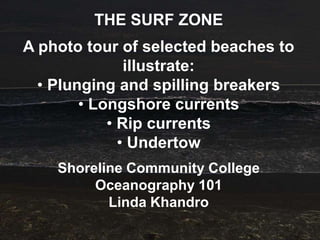
The surf zone
- 1. THE SURF ZONE A photo tour of selected beaches to illustrate: • Plunging and spilling breakers • Longshore currents • Rip currents • Undertow Shoreline Community College Oceanography 101 Linda Khandro
- 2. HOW TO PROCEED • First of all, study ALL the pictures and videos of the surf and beach slope formations in this Power Point. Take your time and enjoy! • STOP when you get to (about) slide 76 with the instructions. This slide and the ones following it, are also attached to the EX6 Assignment page in our Blackboard Week 6 folder. Download and save the file from Blackboard to your hard drive, labeling as usual: lastname_ex6.doc. • Print that file for easy reference as you go through these pictures and videos again. • Answer all the questions on your new file. • When you come to question D, about “rip tides”, rip currents, and longshore currents, BE SURE to go back to slide 74. There you must open the links to see and hear about the formation of rip currents from longshore currents. • Finish answering the questions on your file and attach to the Blackboard Assignment page. • You’re done! Now watch out for rip currents and undertow!
- 15. Some beaches of Baja, Mexico: The west side is on the Pacific Ocean, the south point of Baja is between the Pacific and the Sea of Cortez, and the east side is on the Sea of Cortez. Some of these slides are videos. Mouse over the slide until the white box shows up at the bottom. Click on the arrow at the bottom left side.
- 16. Beach at El Pozo Hondo, near Todos Santos (west side)…
- 20. Los Cerritos beach, near Todos Santos (west side)…
- 25. Beach at Playa Grande, near Cabo San Lucas, south point of Baja
- 37. Beach at San Jose del Cabo, south point of Baja…
- 47. Beach at Cabo Pulmo, east side of Baja (Sea of Cortez)…
- 55. Some beaches of Yucatan, Mexico: Puerto Morelos and Cancun are both on the Caribbean side of the Yucatan Peninsula. Some of these slides are videos. Mouse over the slide until the white box shows up at the bottom. Click on the arrow at the bottom left side.
- 56. Puerto Morelos beach, with the Mesoamerican Reef offshore (white surf)…
- 60. Cancun beach…
- 68. Some beaches of Cape Cod, Massachusetts … .
- 74. THE SURF ZONE Some important points: 1. There are 3 main types of surf, with surging, plunging and spilling breakers, all of which form in response to various factors of the beach slope, including the steepness of the slope. We are discussing only plunging and spilling waves, or breakers, here. 2. A steeply sloping beach face can create a strong undertow. 3. Converging longshore currents can create rip currents. 4. The dangers created by rip currents and undertow are real, but are not the same.
- 75. Fig. 11-12, p. 253
- 76. Fig. 11-14a, p. 255
- 77. Fig. 11-14b, p. 255
- 78. http://oregonstate.edu/dept/ncs/newsarc h/2007/Jul07/ripcurrents.html “If you’re looking out toward the water and you see the long-shore current coming from both the left and right, there’s probably a rip current in front of you.” http://www.nytimes.com/interactive/200 9/01/06/science/20090106- sandslide/index.html
- 79. INSRUCTIONS FOR THE EXERCISE: Now download and print the Blackboard EX6 Assignment page! If you already have it, you’re ready to go back to the beaches slides above, then answer the questions on the Assignment page. Use your Textbook pages 210-211 and the Glossary pages 420 & 423 for further reference to plunging and spilling breakers. The following 7 slides just re-state the questions. Type your answers onto the page you have labeled lastname_ex6.doc.
- 80. A. Plunging Breakers 1. Which of the beaches illustrate, for the most part, “plunging” breakers? Name the beaches as they are labeled on the slides. 2. Which of the beaches with plunging breakers clearly show(s) a steep beach face? 3. What is the significance (or relationship) of this kind of beach slope with respect to the plunging breakers?
- 81. B. Spilling Breakers 1. Which of the beaches illustrate, for the most part, “spilling” breakers? Name the beaches as they are labeled on the slides. 2. What is the general slope of these beaches? 3. What is the significance (or relationship) of this kind of beach slope with respect to the spilling breakers?
- 82. Reef Breakers: In the Puerto Morelos Reef pictures, you can see surf breaking on an offshore reef. 1. What kind of breakers are these, plunging or spilling? If you can’t tell from the photos, consider that the reef has a fairly steep slope on the seaward side.
- 84. D. Rip (tides or currents?) At Playa Grande beach, you will see a red warning sign (previous slide) advising guests not to swim due to the Rip Tide there. 1. Define Rip Tide (if you can!). 2. Define Rip Current. What kind of beach process must be present for a rip current to form? If in doubt, see Slide 78 again.
- 85. 3. According to the beach photos themselves (not the sign), do you see evidence of a Rip Current at Playa Grande? 4. If there is no Rip Current at Playa Grande, how else would you warn potential swimmers here? Look again at the seaward flow of water after the surf breaks; look at the slope of the beach face and think about the fundamental force of nature which creates that flow of water.
- 86. 5. What name (or names) do we give to that seaward flow of water? 6. What is the fundamental force of nature that creates the danger at this beach?